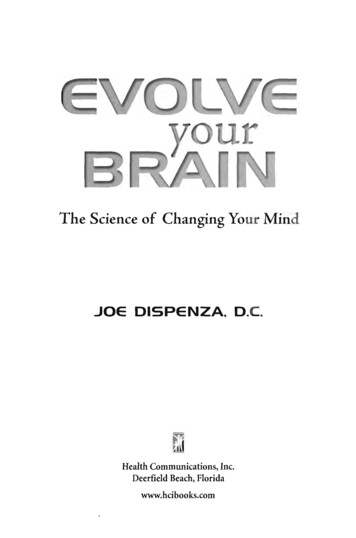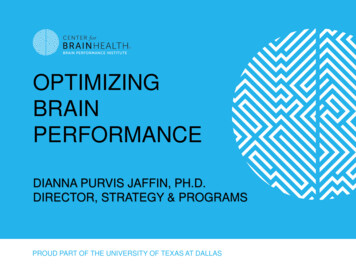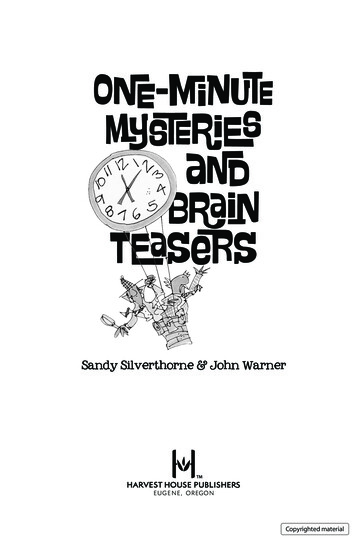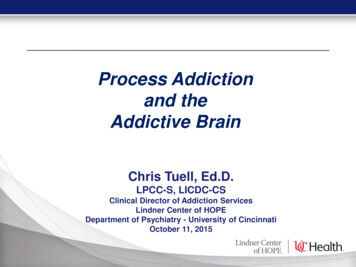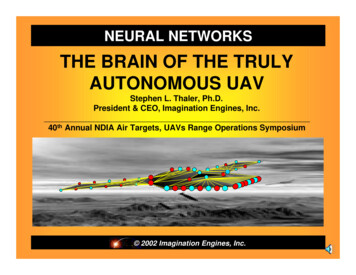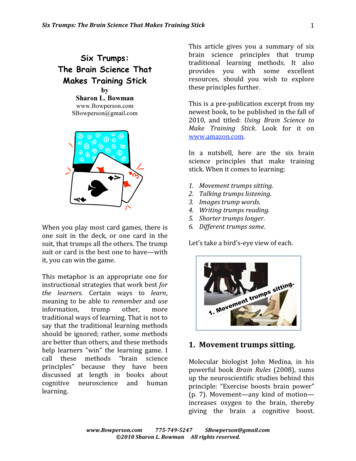
Transcription
Six Trumps: The Brain Science That Makes Training StickSix Trumps:The Brain Science ThatMakes Training StickbySharon L. Bowmanwww.Bowperson.comSBowperson@gmail.com1This article gives you a summary of sixbrain science principles that trumptraditional learning methods. It alsoprovides you with some excellentresources, should you wish to explorethese principles further.This is a pre‐publication excerpt from mynewest book, to be published in the fall of2010, and titled: Using Brain Science toMake Training Stick. Look for it onwww.amazon.com.In a nutshell, here are the six brainscience principles that make trainingstick. When it comes to learning:When you play most card games, there isone suit in the deck, or one card in thesuit, that trumps all the others. The trumpsuit or card is the best one to have—withit, you can win the game.This metaphor is an appropriate one forinstructional strategies that work best forthe learners. Certain ways to learn,meaning to be able to remember and useinformation,trumpother,moretraditional ways of learning. That is not tosay that the traditional learning methodsshould be ignored; rather, some methodsare better than others, and these methodshelp learners “win” the learning game. Icall these methods “brain scienceprinciples” because they have beendiscussed at length in books aboutcognitive neuroscience and humanlearning.1.2.3.4.5.6.Movement trumps sitting.Talking trumps listening.Images trump words.Writing trumps reading.Shorter trumps longer.Different trumps same.Let’s take a bird’s‐eye view of each.1. Movement trumps sitting.Molecular biologist John Medina, in hispowerful book Brain Rules (2008), sumsup the neuroscientific studies behind thisprinciple: “Exercise boosts brain power”(p. 7). Movement—any kind of motion—increases oxygen to the brain, therebygiving the brain a cognitive boost.www.Bowperson.com775 749 5247SBowperson@gmail.com 2010 Sharon L. Bowman All rights reserved.
Six Trumps: The Brain Science That Makes Training StickConversely, sitting for extended lengths oftime makes thinking and learning moredifficult to do because the oxygen levels inthe body decrease.Using This Principle: Learners need tomove much more often than traditionaltraining offers. Standing and stretching,turning and talking, bending and writing,wiggling arms and legs, rolling heads andshoulders—these are a few of the motionsyou can encourage learners to do at leastevery ten to twenty minutes during atraining program. You can also buildmovement into your content‐delivery bydirecting learners to do short, quick,topic‐related review activities thatinclude movement (see the “Articles” linkon my website for free, downloadablemovement‐related review ideas).2“The best way to learn something is to teachit” (p. 185).Using This Principle: Make sure you insertshort,frequent,learnerdiscussionsthroughout the training. Learner discussionscan include pairs, triads, table groups, orwhole group conversations. Discussions canbe as short as one-minute or as long as timeallows. Some examples of short discussioninstructions to learners are:Turn to the person sitting next to you andtell him/her one fact you now know that youdidn’t know before.Tell two people near you three facts you justlearned about the topic.Take two minutes to discuss the implicationsof this information.Ask someone seated near you a quizquestion about the content. Give him/her athumbs up if the answer is correct.2. Talking trumps listening.In his excellent book Informal Learning(2007), technology expert and author JayCross, explains this principle by saying,“Learning is social. We learn from, by, andwith other people” (p. 63). When learnersdiscuss what they’ve heard, they process theinformation three times: first, by listening toit; second, by thinking about it; and third, byrestating it using their own words. An experton the educational implications of brainscience, Patricia Wolfe, sums this up in hergroundbreaking book Brain Matters (2001):3. Images trump words.Wolfe also cites the research demonstratingthe brain’s ability to remember images betterthan words. “The capacity for long-termmemory of pictures seems almost unlimited”(2001, p. 153). When images, even simpleones like photos, stories, or metaphors areadded to the lecture material, the entirewww.Bowperson.com775 749 5247SBowperson@gmail.com 2010 Sharon L. Bowman All rights reserved.
Six Trumps: The Brain Science That Makes Training Stick3learning landscape changes. Instead ofseparate visible parts—a clump of trees, aroad, a signpost, a hill, a car—the mind pullsthese parts together to create a seamlesswhole: a vacation adventure.In the previous paragraph, I used a metaphorto state the obvious: facts become morememorable when learners can use mentalimages to remember them.Using This Principle: Make a commitmentto spend some preparation time gatheringmeaningful photos, clipart, stories, videos,metaphors, and real-life case-studies or jobscenarios, all relevant to the topic. Allowtime for learners to share or create their ownimage-making metaphors and stories. Moreexamples are:Create slides and handout materials thatcontain relevant photos or clipart instead of,or in addition to, printed information.Have learners draw visual representations(doodles, logos, flow charts, and the like) ofimportant content.Use graphic organizers (mind maps, conceptmaps, clustering, or bubbling—do a Googlesearch for free, downloadable graphicorganizers) on which learners can takenotes.Collect both in-house and industry-specificanecdotes, stories, and case studies. Also jotdown relevant stories that learners shareand that (with their permission) you canshare with future classes.4. Writing trumps reading.Writing is a whole-brain task, meaning thatit’s almost impossible to write about onething and think about something else at thesame time. Writing is also multi-sensory, inthat it is kinesthetic, visual-spatial, andtactile. Learners cognitively processinformation a second time when they write itafter hearing it. Furthermore, most learnerswill remember content that they write longerthan the content they hear, or the contentthey read. Jay Cross explains: “Taking notesis a valuable form of processing information known to increase the likelihood ofunderstanding and remembering material”(2007, p. 78).Using This Principle: Remember to stoptalking and give learners a minute or so towrite a short summary of what they learned,three facts about the content, a question theystill have, an opinion, a quiz question, etc.Note-taking tools can be graphic organizers,index cards, post-it notes, paper charts orplacemats, and chart paper taped to walls.www.Bowperson.com775 749 5247SBowperson@gmail.com 2010 Sharon L. Bowman All rights reserved.
Six Trumps: The Brain Science That Makes Training Stick45. Shorter trumps longer.6. Different trumps same.The human brain learns best when content isdivided into smaller “chunks” or segmentsof information. Patricia Wolfe illustrates thisprinciple with the example of phonenumbers. “Phone numbers are notremembered as a list of ten numbers but astwo chunks of three numbers and one chunkof four” (2001, p. 100). Grouping facts intolarger categories or major concepts isanother way of chunking. So is dividingcontent-delivery into shorter segments oftime—about ten or twenty minutes, ratherthan sixty or ninety minutes. John Medinadescribes this process thus: “The way tomake long-term memory more reliable is toincorporate new information gradually andrepeat it in timed intervals” (2008, p. 147).The human brain is hardwired to noticechanges in the learning environment andto ignore sensory data that remainspredictable or the same over time. In hisbook Brain-Based Learning (2000), authorand member of the International Society forNeuroscience, Eric Jensen, states that “anystimuli introduced into our immediateenvironment, which is either new (novel) orof sufficiently strong emotional intensity(high contrast), will immediately gain ourattention” (p. 122). The implications areprofound: the brain will eventually ignoreanything that is routine, repetitive,predictable, or boring. Think abouttraditional lecture methods (facts, nostories), PowerPoint slides that all look thesame, or a sterile learning environment withlittle visual stimulation anywhere—allwhich the brain will eventually ignore.Using This Principle: Time your contentdelivery. Divide all into lecture segmentsinto “chunks” of about ten to twenty minutesin length. If you lose track of time during theclass or training, use a stop watch, timer, orassign a person to hold up a “one minute togo” sign. In between the chunks, engagelearners in short, quick, one-minute reviewactivities in which they move, talk, andwrite.Using This Principle: CHANGE thingsregularly: your instructional methods,learner activities, and the environment.Make sure to engage learners at regularintervals by having them move, talk andwrite. Use the walls and surrounding areasin the room as breakout areas for learners, aswell as areas to which you move whenlecturing (instead of standing in one place infront of the class). Insert relevant, emotionalpieces into your content: stories, photos,www.Bowperson.com775 749 5247SBowperson@gmail.com 2010 Sharon L. Bowman All rights reserved.
Six Trumps: The Brain Science That Makes Training Sticktopic-related jokes, metaphors, analogies,videos, etc.Final ThoughtsIs this a complete list of current brainscience principles that relate to humanlearning? Not at all. Will this list of sixprinciples move you in the direction ofcreating a more brain‐based learningexperience every time you train andteach? Absolutely! Small changes to yourtraining programs can lead to profoundresults for learners. And understandinghow the human brain learns is the firststep towards creating instruction that isbrain‐based, not tradition‐based. Sharon Bowman is a professional trainer, teacher,author, and speaker. She is the president ofBowperson Publishing & Training, Inc. Over 70,000of her seven popular training books are now in print.For free excerpts of her books and other tips andarticles, log onto www.Bowperson.com.Resources cited in this article:Brain-Based Learning. (2000) Eric JensenBrain Matters. (2001) Patricia WolfeBrain Rules. (2008) John MedinaInformal Learning. (2007) Jay CrossSharon’s books (with brain research):How To Give It So They Get It.(5th printing 2009)Preventing Death by Lecture.(4th printing 2008)Training from the BACK of the Room. (2009)The Ten-Minute Trainer (2005)Other resources:Teach Like a Champion. (2010)Doug Lemov12 Brain/Mind Learning Principles in Action.(2005) Renata CaineA Celebration of Neurons. (1995)Robert Sylwesterwww.Bowperson.com775 749 5247SBowperson@gmail.com 2010 Sharon L. Bowman All rights reserved.5
Make Training Stick. Look for it on www.amazon.com. In a nutshell, here are the six brain science principles that make training stick. When it comes to learning: 1. Movement trumps sitting. 2. Talking trumps listen
